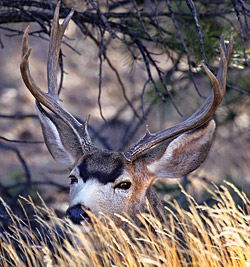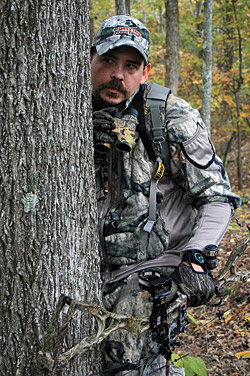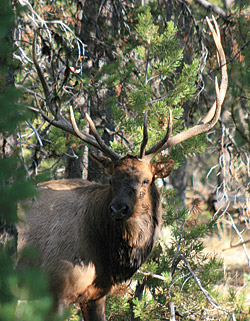October 28, 2010
By Michael D. Faw
Tips for Honing Your Sighting Skills.
By Michael D. Faw
Over there, right behind the fence," I whispered as I slowly moved my hand and pointed across a barbed-wire fence.
My client, however, squinted his eyes and glanced all around, then muttered he did not see the trophy whitetail buck standing broadside 30 yards away. I was guiding the client to a treestand for an afternoon deer hunt. We were walking along the fence when the deer suddenly sprang up from a dense briar thicket. The buck watched us intently as it tried to determine its next move, and I glanced at my client to see if he had spotted the deer. Only that low, rusty, barbed-wire fence and some briars separated us from the deer.
Advertisement
I then whispered features, the distance and other clues to help my client spot the nearby buck. In frustration, the client turned his head, looked at me and said loudly, "Throw a rock at it and get it moving so I can see it." Immediately, the buck bolted, its white tail waving high. My client then spotted the deer.
As a former guide and game warden, I often noted that hunters missed seeing some very obvious deer or overlooked the clues on where a buck, boar or other critter was concealed. Hunters too often look for the entire critter out in the wide open. This is the way most hunters see animals on magazine pages or on hunting videos, so their perception of how easy deer and other beasts are to spot could be jaded. The fact is, there's an art to spotting game.
Advertisement
Aware of the Problem
You can become much better at spotting game, but it will take practice, commitment and a little understanding of basic vision concepts. The first step in becoming a better observer of the natural world is to recognize you might have vision problems. Anyone older than 40 knows vision deteriorates with age, and none of us are getting any younger. If you suspect your eyes are not what they used to be, have your eyes checked by a licensed optometrist.
Next, natural light is far different than the bright green hues emitted by overhead fluorescent lighting. As the nation goes green, more fluorescent lighting is illuminating the way around us. Our eyes have adjusted -- maybe too much. Computer screens, flat panel TVs, office lighting, tinted car windows, sunglasses and other influences have altered the way our eyes collect light and the way our brains process the information it receives. Overcoming the unnatural influences is simple -- spend more time outdoors. Spending time in unfiltered sunlight can help you be better visually in tune with your world.
 Good binoculars can help you peer into the shadows and discover hidden game animals such as this bedded mule deer buck. |
Nature Observation
For some hunters, the only time they see wild deer is while sitting in a treestand during archery season, or brief glimpses while scouting before the season. If that's the case with you, you're missing some great opportunities to enhance your ability to spot wild animals.
Most states now have mapped nature observation routes and designated places to park and look for wildlife. With deer being the most abundant and hunted big-game species, finding and observing deer should be easy. Parks are good places to see wildlife, as are national wildlife refuges, national forests and many other public areas. For example, I had never seen a mountain goat up close until I saw several standing in the parking lot at Mount Rushmore. I learned a lot about that species by observing and photographing those animals for a long period of time.
To enhance your understanding of the big picture when you observe wildlife, always carry and use binoculars, and consider taking photographs. Binoculars help you focus on the small details, and photography helps make you far more aware of lighting and shadows. One of the best ways to train yourself to pick up on small details is to take up bird watching, even if you decide to only watch in your backyard. You'll quickly become adept at using binoculars and/or spotting scopes and learn to focus on slight movement, odd colors and odd shapes. Some common birds, such as a robin or hairy woodpecker, are about the size of a deer's ear. If you can learn to spot those birds with ease, you should be able to detect a deer's ear in the brush.
 When moving through the woods, pause often behind shields such as a thick tree trunk and thoroughly glass the area ahead. |
The Big and Small Details
Several law enforcement and military observation training classes focus on one thing -- teaching the observer to quickly glance at the big picture then look intently at the small details. In a military class I attended, soldiers were told to focus on dark truck, tank or helicopter shapes, then look for individuals, and finally focus intently on uniform patches, hats and rifles. The point was to make a quick determination whether the soldiers were friendly or foes.
In a game warden vision enhancement exercise, the students were shown a picture of a rural scene with a man, a car and a building. After 30 seconds, the projection was removed. Questions were asked about any and all details seen. It was amazing what was missed. The instructor then went back and pointed out important details such as bright red blood on the car's bumper, the hunter's big belt buckle and a rifle and treestand leaning against one side of the building in the background. Game wardens are also taught to look at a hunter's hands and around the fingernails for signs of blood or a reddish-brown substance that could be dried blood. That's looking for very specific details.
You should be getting the big picture and fine details for game spotting by now. To apply vision enhancement afield, practice looking at an outdoor scene, such as across a field and then at the distant wood line. Now, pick out a single tree and look for a knot on a limb or pinecone on that tree. Next, walk over and closely inspect the knot or cone. Is it as you thought?
When looking for deer, elk, bears, boars and other animals, you'll need to start with shapes and lines, then colors and details. Most animal legs make vertical lines, and an animal's back often makes a very noticeable horizontal line in a forest of vertical trees. Deer and elk heads are oval or almost egg-shaped. An elk's rump patch makes a big circular pattern.
With practice, you learn to spot these shapes and lines after one quick glance across an open field or into a forest. Round patterns and flat horizontal lines are pretty obvious in a forest full of vertical trees.
Now, focus on colors. The sun shining through a deer's ear from behind often creates an odd pink hue. In addition to white tails, deer also have white hairs inside their ears, under the head on the neck and along the belly. You might see some or all of these white areas on a bedded deer. Also keep in mind that in direct sunlight, the hair along a deer's back will actually shine with a nearly golden hue.
Yes, elk are also easy to spot. They often appear light in a dark forest filled with pines, as long as the elk is standing against those pines. Place that same animal on the ground against light colored pine needles and the elk begins to blend in. But even then, the dark, chestnut brown legs might stand out. As animals move through fields, forests and brush, they also wear the hair along necks, shoulders and rib cages. The hair just behind the front shoulder or ahead of the rear leg might be lighter in color. This is most noticeable on wet deer and elk, and on wild boars lurking in dark brush. You'll learn the hues with time spent afield.
 Shadows and brush can make an animal hard to see, but slowly scanning the area with binoculars can help you find the parts that make the whole, such as the antlers and an eye on this bull elk. |
Focus, Focus, Focus
It's unbelievable to me, but each year in bowhunting camps across North America I meet hunters who go afield without binoculars. I also find hunters who spend $800 for a bow, $150 for arrows, wear $500 camouflaged clothing and spend $30 on binoculars. I never go hunting without quality binoculars.
It's a fact: If you don't see an animal, you're not going to shoot it. Period.
Binoculars have many uses afield. You can better judge animals you spot at a distance and determine whether to pursue them or save your energy and move on. You can also observe other hunters. Finally, and most importantly, binoculars dramatically increase your ability to pick apart brush and look for the shapes, colors and movements that give away an animal's location.
Antlers, eyes, ears and other animal parts become easier to spot when your world is magnified. With quality binoculars, it's easy to think of the area ahead of you as a big puzzle, and you are going to scan it and closely look at how the pieces go together. In most cases, it's easy to look at the view much like reading a book. Scan left to right up high, then drop down and scan again, until finally you scan and see at ground level. Be certain to stop and peer into brush or downfalls, because those are areas where big animals prefer to hide. Remember also to keep your binoculars focused as you scan near and far. To be certain your binoculars are in focus, read the adjustment directions or contact the manufacturer. Each barrel of most binoculars can -- and should -- be adjusted to your individual eyes.
Everyone who bowhunts has read the warnings against releasing a bowstring while binoculars or a game call hangs on your chest. The simple solution is to wear a chest harness to suspend your binoculars. Tuck them inside your open coat or shirt top when you are not viewing or searching. The binoculars are out of the way there and will be protected from the elements while remaining easily accessible.
One other critical factor interferes with your ability to spot game -- movement. If you are moving, you miss a lot. Pause often and take long periods of time to scan the woods around your stand or the hillside ahead. Humans have been hunters for millennia, and we're programmed to notice movement. If you think you saw something move up ahead or off to the side in your peripheral vision, stop and search the area in detail with your binoculars. Most times you'll discover there really was something there.
You can also aid your vision by wearing a cap with a brim. The brim helps keep harsh light and glares out of your eyes, and you can hold onto the brim with a few fingers while you use your binoculars. This, and tucking your elbows against your chest and ribs, will help you hold your binoculars steadier and make your view much clearer. When sitting in a treestand, try resting your elbows on your legs as you use binoculars to scan the area. Note also that the most effective method to use binoculars is to spot an object and then raise the binocular up and into your line of vision. Looking down into the binocular leads to swinging and scanning as you search for the object or beast you want to see. Those wasted seconds could be the difference between getting the game or the game getting away.
Increasing your ability to spot more game takes the same practice you use to become more accurate with a bow. You need to practice often and with a purpose in
